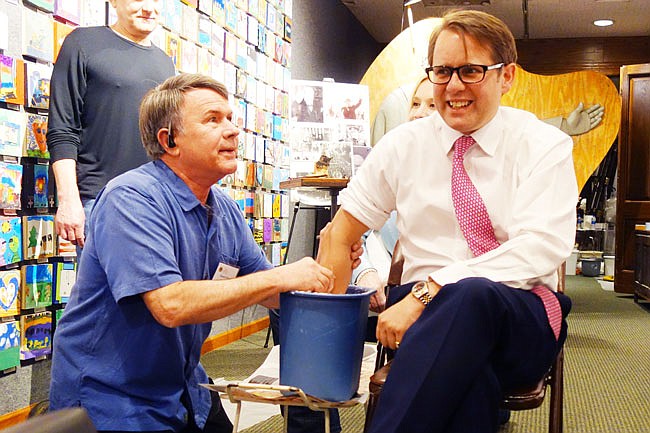Thanks to sculptor Donald Wiegand, the Churchill Museum's 50th anniversary celebration will be commemorated in art.
Saturday morning, he created lifecasts of several of the event's special guests, which will be arranged together in a symbolic work.
"We're doing their hands holding flags," he explained. "This represents the great partnership (between Great Britain and America) that has preserved our planet."
Several of Sir Winston Churchill's descendants gamely dunked their hands in buckets of dental rubber for the project.
"There's a moment where you think, 'We're stuck,'" said Churchill's great-grandson Jack Churchill.
Churchill's granddaughter Emma Soames and Duncan Sandys (nephew of Churchill's granddaughter Edwina Sandys) also sat to be cast. A grandson of former U.S. President Harry S. Truman was unable to make it to Saturday morning's event.
Wiegand also works in bronze and created the bust of Winston Churchill mid-Iron Curtain speech that stands outside the museum. However, lifecast hands have become a specialty of his. The Chesterfield-based artist has cast the hands of such dignitaries as former President George H.W. Bush and his wife, Barbara Bush.
"I was going to use the presidential bucket for the Truman grandson," he said.
Unlike bronze, gypsum-based plaster doesn't shrink as it hardens, meaning it creates a much more accurate cast. As long as it doesn't get smashed or wet, it lasts more or less indefinitely, Wiegand said.
"This technique began in about 5,000 B.C.," he added.
He likes to allow his subjects to cut away the rubber mold, or negative, revealing the completed cast.
"It's taking the negative away from your life," he said.
Soames said she enjoyed participating in the art project.
"It's marvelous to be here," she said.
Wiegand is the founder of the nonprofit Wiegand Foundation, which memorializes important figures in national defense, science, health and tech.

